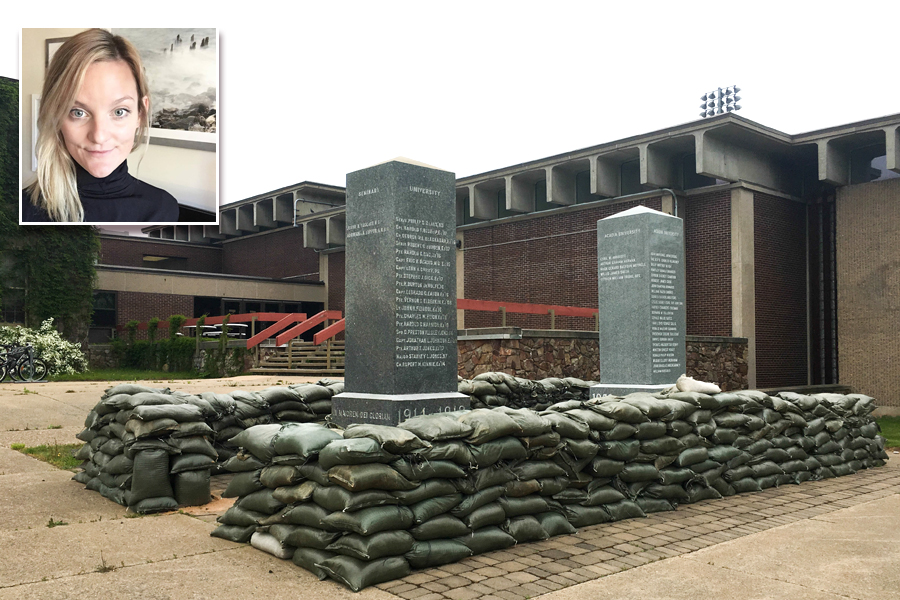Uncommon art creates buzz at war memorial
By Lookout on Aug 05, 2017 with Comments 0

A view of the trench Nova Scotia artist and Afghanistan War veteran Jessica Lynn Wiebe built at the First and Second World War Monuments on the campus of Acadia University.
Peter Mallett, Staff Writer ~
The newest project by artist Jessica Lynn Wiebe involved filling and stacking 550 sandbags around the First and Second World War monuments at the Acadia War Memorial in Wolfville, Nova Scotia.
The former Canadian Armed Forces Reservist, now an Artist in Residence at the MacPhee Centre for Creative Learning in Dartmouth, N.S., says her performance art piece was physically demanding to create, and unorthodox.
In late May, as part of King’s County Uncommon Common Art Exhibit, Wiebe and a team of participants (veterans and civilians) built a trench wall around the war monuments located on the Acadia University campus.
“Monuments tend to merge with the landscape over time and become invisible in our every day. The temporary trench built around the war memorial protects memory and disrupts the invisibility,” explains Wiebe. “This performance-based installation investigates the physical experience and sacrifices of war that monuments represent. It is about linking a new generation of soldiers and their experience of war with former generations, and at the same time bridging the gap between civilian understanding and military experience.”
The 29-year-old graduate of the Nova Scotia College of Art and Design draws inspiration from first-hand experience. Wiebe was an artillery gunner with the 26th Field Artillery Regiment in her home province of Manitoba, and in 2008 deployed to Afghanistan with the 2nd Battalion, Princess Patricia’s Canadian Light Infantry (PPCLI).
“Coming home from that experience [in Afghanistan] changes you,” says Wiebe. “Art does not always have to be cathartic or have healing power, art can be art. But I also believe it is important to artistically document Canada’s role in Afghanistan.”
Her ink drawings and mixed media sketches documenting the conflict in Afghanistan were exhibited at the Army Museum in Halifax’s Citadel Hill in 2013 and are still on display. In the collection is a variety of images portraying Canadian military members and civilians to showcase the human side of war.
“As an artist, I feel it’s important to document not only the intensity of war, but also the daily activities of soldiers in training and in the downtime, sitting and waiting for their next set of orders.
“I remember watching motorcycles and trails of dust, vehicles overpopulated with people, animals and cargo, and the Afghan landscape; the dull beige landscape camouflages my experience and memories and finds its way into my work,” says Wiebe.
As part of this performance art piece, she packed a 25-kilogram concrete sandbag sculpted by hand into a rucksack and marched 14 kilometres from Camp Aldershot, where the sand bags were prepared, to the war memorial in Wolfville following the old Dominion Atlantic Railroad. The old railroad is now a walking and biking path that runs along Nova Scotia.
“The Dominion Atlantic Railroad transported thousands of soldiers from around Nova Scotia to Camp Aldershot for basic training before being sent to the trenches and battlefields of the First and Second World War,” she says. “The march was a genuine effort to symbolically tie the performance to the soldiers training and being transported through this landscape.”
Filed Under: Top Stories
About the Author:





